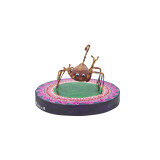Alacran Base Mini - folk art from Mexico - height 5x8 cm
- Original handicraft made of polychrome clay
- Unique object made in the spirit of Mexican popular art
- Only a few pieces on sale
- Intense colors, accurate hand decorations
- Dimensions: height 5 x 8 cm
Small animal figurines
Decorating homes with small animal figurines is a very popular style in Mexico, dating back to Mayan and Aztec times. These are often figurines of wild cats, tigers or pumas, or popular insects and amphibians found in many species. The figurines were intended to decorate the modest and unassuming spaces of Mexican homes. Animal figurines may be decorated with regular geometric patterns characteristic of Aztec design in shades of blue, yellow, red, green, and black. The figurines may refer to the popular Catrin or have nothing to do with this style at all. In addition to wild animals, it is also common for the figures to depict domestic animals such as cows, horses, dogs and cats.
Figurines in the Talavra style
The figurines are produced in the Talavera style, which was brought to Mexico with the Spanish colonizers in the 16th century from the town of Talavera de la Reina. This style of ceramic production is characterized by firing the pottery in a special kiln, decorating the figurines with the artist's own hands, applying a layer of glaze and firing again. This method of production allows to obtain a durable, resistant to damage figurine, which is decorated with patterns of deep saturation. Each of the figurines is signed by a Mexican craftsman. The unique workmanship makes the figurines often sought after by collectors from around the world.
Decorating homes with small animal figurines is a very popular style in Mexico, dating back to Mayan and Aztec times. These are often figurines of wild cats, tigers or pumas, or popular insects and amphibians found in many species. The figurines were intended to decorate the modest and unassuming spaces of Mexican homes. Animal figurines may be decorated with regular geometric patterns characteristic of Aztec design in shades of blue, yellow, red, green, and black. The figurines may refer to the popular Catrin or have nothing to do with this style at all. In addition to wild animals, it is also common for the figures to depict domestic animals such as cows, horses, dogs and cats.
Figurines in the Talavra style
The figurines are produced in the Talavera style, which was brought to Mexico with the Spanish colonizers in the 16th century from the town of Talavera de la Reina. This style of ceramic production is characterized by firing the pottery in a special kiln, decorating the figurines with the artist's own hands, applying a layer of glaze and firing again. This method of production allows to obtain a durable, resistant to damage figurine, which is decorated with patterns of deep saturation. Each of the figurines is signed by a Mexican craftsman. The unique workmanship makes the figurines often sought after by collectors from around the world.
Product Details
- Product code: BIZ-277
- Manufacturer: Cerames
- Colour Multicolor
- Material Ceramic
- Application Inside
- Country of origin Mexico








